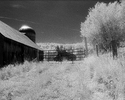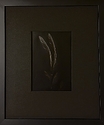If for archival quality you mean that some file formats such as 3f might be "forgotten" in the future and hard to convert to some other format, then I think for archival purposes a standard file format such as TIFF is the best option. Linear-DNG is probably the best next option.
Regarding which format to use to save a scan, a "raw" file from a scanner is not like a "raw" from a digital camera. A "raw" scan has complete RGB information so that you can see and save it as a TIFF, even though it is a raw file from the point of view of the scanning process, because you have not yet applied curves to it. There are many "levels" or "rowness" in a scan row file, depending on how you configure the scanner. A 3f file (I don't know this format) will again be an RGB file with some added information, so it is correct to say that it is a TIFF with some added information. A TIFF if I get it right is a very simple object, basically an array of RGB pixel values. The 3f file probably just "explicits" the settings that were adopted during scanning so that the corresponding application know with what settings the raw file was created.
I suggest deciding exactly what kind of "raw" file you want (do you want ICE correction, do you want to set black and white points, do you want to attach a scanner profile, do you want to set black and white point, do you want to apply gamma curves, do you want to apply film curves, do you want to invert colours... the more of those things to do, the "less raw" is your raw), and then save it in TIFF because you know that, many years from now, it will be easier to open it. The 3f format might be not supported in the future and maybe the extraction of the "bare TIFF information" might be not banal.
Personally I save slides as "Linear DNG" file of my slides with VueScan. I set the scanner profile, let the scanner set black and white point (with 0% clipping on both sides) and scan without applying any film curve. I then open the files in Lightroom. This works very well for slides, and it is good in the long run as "linear DNG" should be around for a long time. Those files don't have gamma curves applied, they are "linear", i.e. they have gamma = 1.
I save scans of colour negatives as "TIFF-raw" with VueScan and open them directly in Photoshop and invert them with ColorPerfect. I prefer the inversion curves of ColorPerfect vs the internal Photoshop inversion curves, or VueScan's ones. Those are negative TIFF-files and again I suppose the TIFF format is around in the long run.
Those TIFF-raw file also have gamma = 1 so they are "linear".
The only intervention before the writing of the scan file is the ICE scratch reduction, the black and white point, the scanner profile. My "raw" file incorporate only these levels of intervention. All other modifications are done in a later stage of post-processing (white balancing, gamma curves, fine tuning of white point and black points, contrast curves, saturation, and obviously horizontality, spotting etc).
The reason why I create a TIFF-raw with negative instead of a Linear-DNG-raw as I do with slides is that ColorPerfect, which is a Photoshop Plug-In I use for the colour inversion, needs a linear negative (gamma = 1), and Photoshop needs a TIFF file (cannot open a DNG file directly). Lightroom cannot export a "linear" TIFF that I can open to Photoshop, Lightroom insists in applying gamma curves to TIFF files. The best I found so far is to create a TIFF-raw with VueScan and pass it to Photoshop and convert it with ColorPerfect.





